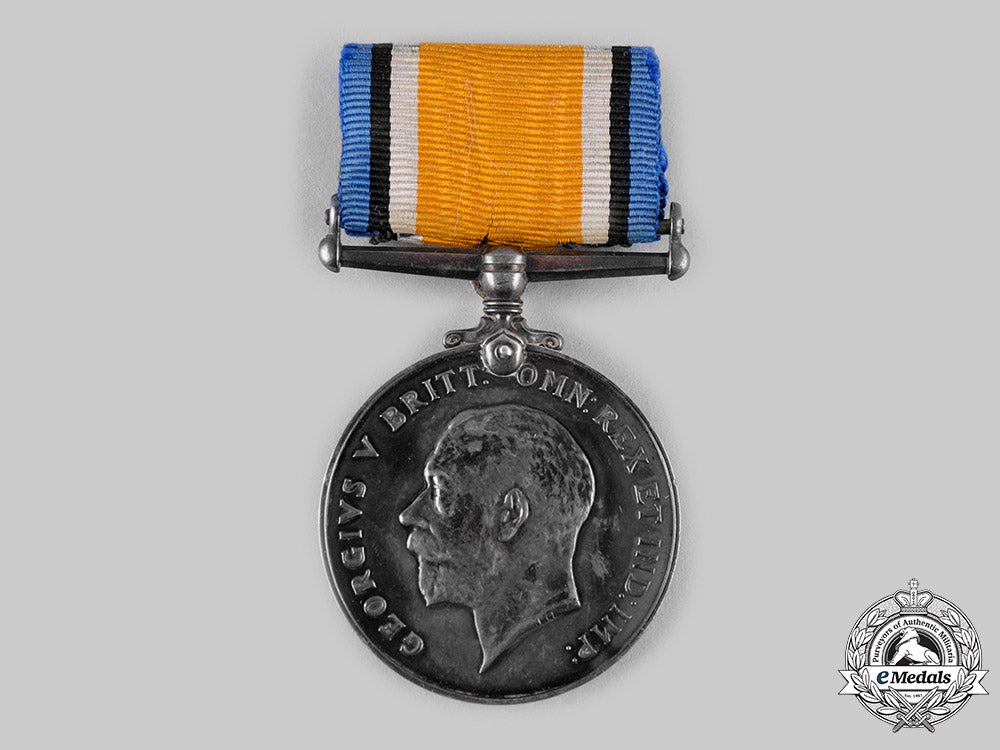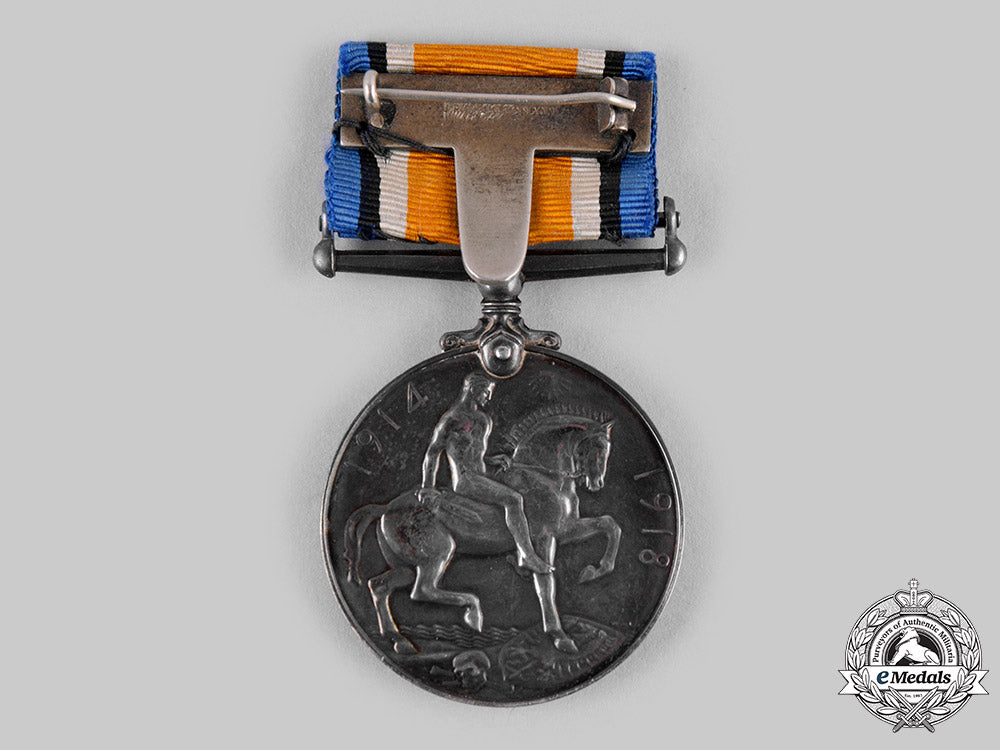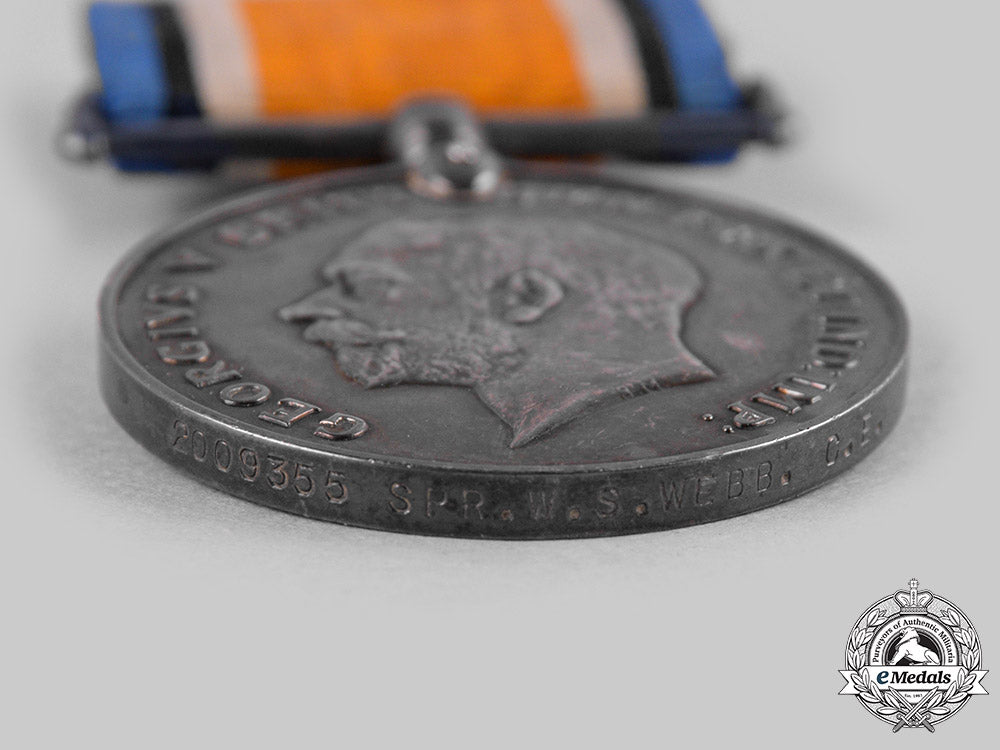
LOADING ...
In response to evolving domestic opinion, eMedals Inc has made the conscious decision to remove the presentation of German Third Reich historical artifacts from our online catalogue. For three decades, eMedals Inc has made an effort to preserve history in all its forms. As historians and researchers, we have managed sensitive articles and materials with the greatest of care and respect for their past and present social context. We acknowledge the growing sentiments put forth by the Canadian public and have taken proactive actions to address this opinion.



Canada. First War British War Medal, To Sapper Walter Samuel Webb, Canadian Engineers
Canada. First War British War Medal, To Sapper Walter Samuel Webb, Canadian Engineers
SKU: ITEM: C5988
0% Buyer's Premium
Current Bid:
Your Max Bid:
Bid History:
Time Remaining:
Couldn't load pickup availability
Shipping Details
Shipping Details
eMedals offers rapid domestic and international shipping. Orders received prior to 12:00pm (EST) will be shipped on the same business day.* Orders placed on Canadian Federal holidays will be dispatched the subsequent business day. Courier tracking numbers are provided for all shipments. All items purchased from eMedals can be returned for a full monetary refund or merchandise credit, providing the criteria presented in our Terms & Conditions are met. *Please note that the addition of a COA may impact dispatch time.
Shipping Details
eMedals offers rapid domestic and international shipping. Orders received prior to 12:00pm (EST) will be shipped on the same business day.* Orders placed on Canadian Federal holidays will be dispatched the subsequent business day. Courier tracking numbers are provided for all shipments. All items purchased from eMedals can be returned for a full monetary refund or merchandise credit, providing the criteria presented in our Terms & Conditions are met. *Please note that the addition of a COA may impact dispatch time.
Description
Description
(2009355 SPR. W.S. WEBB. C.E.). Naming is officially impressed. Dark patina, very light contact, original ribbon, maker marked "J.R. GAUNT LONDON" on the pinback, extremely fine.
Footnote: Walter Samuel Webb was born on April 13, 1899 in Toronto, Ontario. He had had the measles, the mumps and the chicken pox in childhood, with no complications. Webb was a resident of Toronto when he signed his Attestation Paper as a Sapper (2009355) with the Canadian Engineers, on May 29, 1918 in Toronto, at the age of 19, naming his next-of-kin as his mother, Laura Webb of Toronto, stating that he had no previous military service, that he was not married, that his religion was Church of England and that his trade was that of Driver. He was transferred to the Engineering Depot at Brockville, Ontario on June 6, 1918. Sapper Webb was transferred to the 57th Draft, Canadian Engineers for service in the European theatre, on July 12, 1918, embarking Montreal, Quebec that day and arriving in Halifax, Nova Scotia on the 18th. Nine days after arriving in Halifax, he developed a medical issue while waiting for his transport to Europe and was treated at Cogswell Street in downtown Halifax, on July 28th. The doctor who performed the examination described Webb's condition: "Yesterday (27th), while out with a 'lady', (he) had considerable sexual excitement without orgasm, which was followed by pain and soreness in (the) testes. For which he came to hospital, during (the) night and after rest, (the) pain and soreness passed away. Evidently a simple case of testicular congestion". After three days, he was discharged to duty on the 31st. Sapper Webb embarked Halifax on August 3, 1918, arriving in Liverpool, England on the 16th, where he was taken on strength of the 3rd Canadian Engineers Regimental Depot at Seaford, Sussex and briefly placed on command at Purley from the 16th to the 22nd. Six weeks after arriving in England and still attached to the Canadian Engineers Regimental Depot, he received a medical examination, as he was experiencing "issues" while training with his unit at Seaford. He was diagnosed "D.A.H." (Disordered Action of the Heart, otherwise known as Soldier's Heart or Effort Syndrome, and was thought to result from a combination of over exertion, mental stress and fatigue) during his medical exam at the SMB Rooms at Seaford. In his Proceedings of a Medical Board Report, dated September 27, 1918 at Seaford, the attending physician stated that Webb "Has not been to France. Never had and serious illness but complains of pains during marches under full equipment, and has had to fall out frequently because of dizziness". He was declared to be "Fit for Duty, B11". The condition continued, forcing him to be medically reassessed on November 16th at Seaford. The doctor noted that Webb had had "no hospital entries to this point" and that the "soldier states (that he) had no trouble with (his) heart before entering the army. Pain and shortness of breath has troubled him ever since. He has not been to Europe. Never had any serious illness". Seeing as hostilities had ceased five days earlier and that his condition remained of concerned to the doctors, he was struck off strength of the Overseas Military Forces of Canada, posted to camp for return to his homeland. Sapper Webb sailed for Canada on December 7, 1918 aboard the S.S Olympic, arriving in Halifax, Nova Scotia on the 14th. He was subsequently posted to the Casualty Company at Exhibition Camp in Toronto, where it was noted that he was suffering from "stress of service (route marches, etc.), (from) excessive smoking" during his medical exam. In his Medical History of an Invalid Report, dated January 9, 1919 at Exhibition Camp in Toronto, the attending physician noted that Webb had "Partial loss of function of (the) heart" and that he was a "Poorly nourished boy of 19". He went on to state that Webb "Experiences sharp shooting pain in (the) heart. Pain lasts about 5 minutes and is felt once a day at once in 2 days. Feels somewhat weak during attacks of pain and has slight shortness of breath. First felt pain in (the) left side of (his) chest in front, on July 12, 1918 after a day of severe heat and drill. Felt a little weak but was able to carry on. Felt pain at intervals of once or twice a week with little or no weakness of a month or so. One hot day in August, after walking 7 miles on a route march, felt a severe pain in (the) heart region and almost immediately fainted on the march and was carried on a stretcher. Rested a few days and upon resuming duty, felt some pain at intervals. Fainted after working 3 or 4 times in (the) next few weeks. Has been a heavy cigarette smoker before and after enlistment - 10 to 20 a day". The Medical Board at Exhibition Camp recommended that he be declared Category "E" (unfit for General Service, Service Abroad and Home Service). Sapper Walter Samuel Webb, Canadian Engineers was discharged as "having been found medically unfit for service" at No. 2 District Depot in Toronto, on January 18, 1919, credited with having served in Canada and England, the latter of which was for only four months. For his First World War service, he was awarded the British War Medal.
Description
(2009355 SPR. W.S. WEBB. C.E.). Naming is officially impressed. Dark patina, very light contact, original ribbon, maker marked "J.R. GAUNT LONDON" on the pinback, extremely fine.
Footnote: Walter Samuel Webb was born on April 13, 1899 in Toronto, Ontario. He had had the measles, the mumps and the chicken pox in childhood, with no complications. Webb was a resident of Toronto when he signed his Attestation Paper as a Sapper (2009355) with the Canadian Engineers, on May 29, 1918 in Toronto, at the age of 19, naming his next-of-kin as his mother, Laura Webb of Toronto, stating that he had no previous military service, that he was not married, that his religion was Church of England and that his trade was that of Driver. He was transferred to the Engineering Depot at Brockville, Ontario on June 6, 1918. Sapper Webb was transferred to the 57th Draft, Canadian Engineers for service in the European theatre, on July 12, 1918, embarking Montreal, Quebec that day and arriving in Halifax, Nova Scotia on the 18th. Nine days after arriving in Halifax, he developed a medical issue while waiting for his transport to Europe and was treated at Cogswell Street in downtown Halifax, on July 28th. The doctor who performed the examination described Webb's condition: "Yesterday (27th), while out with a 'lady', (he) had considerable sexual excitement without orgasm, which was followed by pain and soreness in (the) testes. For which he came to hospital, during (the) night and after rest, (the) pain and soreness passed away. Evidently a simple case of testicular congestion". After three days, he was discharged to duty on the 31st. Sapper Webb embarked Halifax on August 3, 1918, arriving in Liverpool, England on the 16th, where he was taken on strength of the 3rd Canadian Engineers Regimental Depot at Seaford, Sussex and briefly placed on command at Purley from the 16th to the 22nd. Six weeks after arriving in England and still attached to the Canadian Engineers Regimental Depot, he received a medical examination, as he was experiencing "issues" while training with his unit at Seaford. He was diagnosed "D.A.H." (Disordered Action of the Heart, otherwise known as Soldier's Heart or Effort Syndrome, and was thought to result from a combination of over exertion, mental stress and fatigue) during his medical exam at the SMB Rooms at Seaford. In his Proceedings of a Medical Board Report, dated September 27, 1918 at Seaford, the attending physician stated that Webb "Has not been to France. Never had and serious illness but complains of pains during marches under full equipment, and has had to fall out frequently because of dizziness". He was declared to be "Fit for Duty, B11". The condition continued, forcing him to be medically reassessed on November 16th at Seaford. The doctor noted that Webb had had "no hospital entries to this point" and that the "soldier states (that he) had no trouble with (his) heart before entering the army. Pain and shortness of breath has troubled him ever since. He has not been to Europe. Never had any serious illness". Seeing as hostilities had ceased five days earlier and that his condition remained of concerned to the doctors, he was struck off strength of the Overseas Military Forces of Canada, posted to camp for return to his homeland. Sapper Webb sailed for Canada on December 7, 1918 aboard the S.S Olympic, arriving in Halifax, Nova Scotia on the 14th. He was subsequently posted to the Casualty Company at Exhibition Camp in Toronto, where it was noted that he was suffering from "stress of service (route marches, etc.), (from) excessive smoking" during his medical exam. In his Medical History of an Invalid Report, dated January 9, 1919 at Exhibition Camp in Toronto, the attending physician noted that Webb had "Partial loss of function of (the) heart" and that he was a "Poorly nourished boy of 19". He went on to state that Webb "Experiences sharp shooting pain in (the) heart. Pain lasts about 5 minutes and is felt once a day at once in 2 days. Feels somewhat weak during attacks of pain and has slight shortness of breath. First felt pain in (the) left side of (his) chest in front, on July 12, 1918 after a day of severe heat and drill. Felt a little weak but was able to carry on. Felt pain at intervals of once or twice a week with little or no weakness of a month or so. One hot day in August, after walking 7 miles on a route march, felt a severe pain in (the) heart region and almost immediately fainted on the march and was carried on a stretcher. Rested a few days and upon resuming duty, felt some pain at intervals. Fainted after working 3 or 4 times in (the) next few weeks. Has been a heavy cigarette smoker before and after enlistment - 10 to 20 a day". The Medical Board at Exhibition Camp recommended that he be declared Category "E" (unfit for General Service, Service Abroad and Home Service). Sapper Walter Samuel Webb, Canadian Engineers was discharged as "having been found medically unfit for service" at No. 2 District Depot in Toronto, on January 18, 1919, credited with having served in Canada and England, the latter of which was for only four months. For his First World War service, he was awarded the British War Medal.



You May Also Like
Japan, Empire. A T90 Civil Defense Helmet, c.1943
W8287
Germany, SA. A Model 1933 Service Dagger, SA-Gruppe Nordsee, by Friedrich von der Kohlen
G59818
Germany, SA. A Model 1933 Service Dagger, SA-Gruppe Pommern, by Gustav Wirth
G59816
Germany, Third Reich. A Mixed Lot of Tyrolean Marksmanship Badges
G52930
Germany, SS. An Estonian Waffen-SS Volunteer’s Sleeve Shield
G50381
-
Japan, Empire. A T90 Civil Defense Helmet, c.1943
W8287
Add to CartRegular price $275 USDRegular price $0 USD Sale price $275 USDUnit price / per -
Germany, SA. A Model 1933 Service Dagger, SA-Gruppe Nordsee, by Friedrich von der Kohlen
G59818
Add to CartRegular price $980 USDRegular price $0 USD Sale price $980 USDUnit price / per -
Germany, SA. A Model 1933 Service Dagger, SA-Gruppe Pommern, by Gustav Wirth
G59816
Add to CartRegular price $980 USDRegular price $0 USD Sale price $980 USDUnit price / per -
Germany, Third Reich. A Mixed Lot of Tyrolean Marksmanship Badges
G52930
Add to CartRegular price $135 USDRegular price $0 USD Sale price $135 USDUnit price / per -
Germany, SS. An Estonian Waffen-SS Volunteer’s Sleeve Shield
G50381
Add to CartRegular price $150 USDRegular price $0 USD Sale price $150 USDUnit price / per
Do you have a similar item you are interested in selling?
Please complete the form and our client care representatives will contact you.
Sell Item










